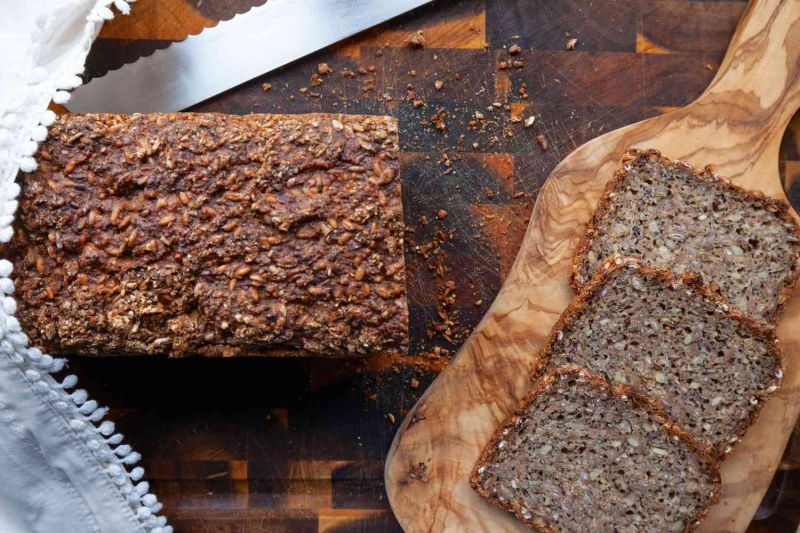Prep: 3 hrs
Cook: 90 mins
Total: 4 hrs 30 mins
Servings: 12 servings
Yield: 1 loaf
The best thing about Danish rye bread, or rugbrød, is the way it beautifully blurs the line between porridge and bread. It’s a little bit like fermented oatmeal that you can slice and toast. One of the most flavorful yet still-versatile breads, this rye is equally fantastic toasted and buttered for breakfast, or as the foundation of an open-faced sandwich at lunchtime. Also like porridge, it’s simple to make and open to customization. Substitute different seeds or nuts, or even try it with a bit of dried fruit. The dough doesn’t require a lot of mixing, kneading, or fancy slashes. Just mix it up, let it sit around for a while, and bake it in a pan.
The most challenging aspect of this recipe is the sourdough starter. Unfortunately with this bread, commercial yeast just won’t do. But if sourdough isn’t something you’ve gotten into, this bread is a great place to start. If you don’t have a starter and don’t want to go to the trouble of starting your own (though it’s probably easier than you think), see if your local artisan bakery will hook you up. The effort will be well worth it.
Finally, if you’re not a bread geek, you may not be accustomed to seeing ingredients measured in grams. It’s by far the best way of doing things. There are excellent kitchen scales available for this purpose for around twenty dollars.
Ingredients
-
80 grams buttermilk
-
60 grams dark beer
-
10 grams honey
-
170 grams spelt flour
-
65 grams dark rye flour
-
90 grams whole flax seeds
-
45 grams hulled hemp seeds
-
45 grams sunflower seeds
-
14 grams salt
-
230 grams whole rye berries
-
220 grams water
-
150 grams active sourdough starter
Steps to Make It
-
Fully submerge the rye berries in water and soak them for twelve hours. Drain them after soaking.
-
Add all ingredients to a large bowl and mix until well combined.
-
Cover the bowl and leave it somewhere around 70 to 75 F to ferment for about 3 hours. After that time you should notice some visible fermentation activity. Due to the quality of the gluten, as well as all the heavy whole grains and seeds, the dough won’t rise much, but if you don’t see any bubbles, etc. then keep waiting, up to a maximum of 5 hours.
-
Butter or oil a 4×9 Pullman-style loaf pan with a sliding lid, and using a flexible dough scraper, gently pour the dough into the open pan. It should fill about half the space.
-
Let the dough ferment (technically, “proof” — the term for fermentation that takes place after the loaf has been shaped) for 2 more hours at the same ambient temperature.
-
Refrigerate the dough in the covered pan for 12 to 16 hours.
-
Preheat the oven to 425 F. Remove the pan, cover on, from the refrigerator and put it into the hot oven. After 20 minutes, remove the pan’s cover and continue to bake for another 55-70 minutes, or until a thermometer inserted in the center of the loaf reads at least 205 F.
-
Remove the loaf to a cooling rack. After the loaf has cooled to room temperature, wrap it in a clean kitchen towel. Wait 24 hours before slicing.
| Nutrition Facts | |
|---|---|
| Servings: 12 | |
| Amount per serving | |
| Calories | 232 |
| % Daily Value* | |
| Total Fat 8g | 10% |
| Saturated Fat 1g | 4% |
| Cholesterol 0mg | 0% |
| Sodium 811mg | 35% |
| Total Carbohydrate 33g | 12% |
| Dietary Fiber 7g | 26% |
| Total Sugars 4g | |
| Protein 9g | |
| Vitamin C 4mg | 19% |
| Calcium 57mg | 4% |
| Iron 3mg | 15% |
| Potassium 306mg | 7% |
| *The % Daily Value (DV) tells you how much a nutrient in a food serving contributes to a daily diet. 2,000 calories a day is used for general nutrition advice. | |


